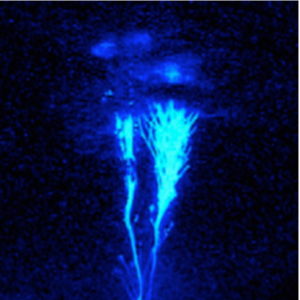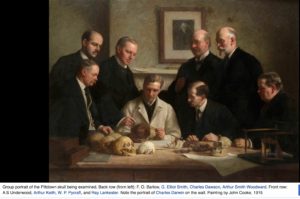Paper 57 Paper 59
See Wikipedia: Francis Harry Compton Crick OM FRS (8 June 1916 – 28 July 2004) was a British molecular biologist, biophysicist, and neuroscientist, most noted for being a co-discoverer of the structure of the DNA molecule in 1953 with James Watson. Together with Watson and Maurice Wilkins, he was jointly awarded the 1962 Nobel Prize in Physiology or Medicine “for their discoveries concerning the molecular structure of nucleic acids and its significance for information transfer in living material”. Crick theorized about directed panspermia. Wikipedia page: directed panspermia, which concerns the deliberate transport of microorganisms in space to be used as introduced species on lifeless planets.
See Etymology of Coined Terminology.
Introduction
Section 1: Physical-life Prerequisites
p7: metric conversion: “These ancient inland seas were seldom over 150–180 m deep, and sunlight can penetrate ocean water for more than 180 m.”
Section 2: The Urantia Atmosphere
Matthew Block suggests that the following author was influential in writing of this Section and has prepared a parallel chart:
Dr. Harlan True Stetson, “Solar Radiation and the State of the Atmosphere,” The Scientific Monthly, Vol. 54, No. 6 (June 1942) Wikipedia page. Digital archive of the article.
p2: metric conversions: “a level about 16 km above the surface of the earth, and which extends spaceward for another 16 km. . . .would make a layer only 2.5 mm thick; nevertheless . . .”
In 2000, ozone thickness was estimated at about 3mm.
p2,4: ozone See Topical Study: Health and Healing.
p3: fifty thousand facts In 2021, Stephen Meyer published Return of the God Hypothesis: Three Scientific Discoveries That Reveal the Mind Behind the Universe. He was interviewed on Uncommon Knowledge with Peter Robinson. He is vilified by Wikipedia: “He is an advocate of intelligent design, a pseudoscientific creationist argument for the existence of God, presented with the claim that it is “an evidence-based scientific theory”.” Is the Wikipedia culture working with or against Urantia Book teachings? Where does it draw from and what is the impact of this cultural influence?
View/read presentations from the 2016 Urantia Foundation Scientific Symposium inspired by this passage.
p6: Urantia Book enthusiasts and critics alike have long considered the reference to an “inner ionosphere” to be a mistake because the longstanding understanding of the earth’s atmosphere has been that the ionosphere exists above the stratosphere. However, in the late 1980’s and early 1990’s observations of “blue jets” were conclusively documented and accepted as an atmospheric condition. Notwithstanding that this phenomenon is still not well understood, what has been learned about blue jets indicates that there must be an ionospheric layer below the stratosphere. Blue jets form above thunderclouds and often reach a height of about 25 miles above sea level. The long-recognized ionosphere, which exists above the stratosphere, begins at around 30 miles above sea level. Calculations based on videos taken of blue jets, as well as other associated research, indicate that the ionic condition necessary to create their luminescent quality could not have its source in the thunderclouds over which they occur. See UBtheNEWS Inner Ionosphere Report.
Blue Jets Shooting Up From Storm Clouds

metric conversions: “The lower 8 or 10 km of the earth’s atmosphere . . . steadily falls for 9 or 12 km, at which height it registers around -57 °C. This temperature range of from -54 °C to -57 °C is unchanged in the further ascent for 64 km . . . At a height of 72 or 80 km, the temperature . . . a temperature of 649 °C is attained . . . about 643 km.”
Section 3: Spatial Environment
p1: atom At Urantia Foundation’s Scientific Symposium in 2016, Dick Reim presented a Urantia Book-inspired reworking of the periodic table. View the video. Read the pdf.
Section 4: The Life-dawn Era
p2: From phys.org in June 2022: “New research led by scientists at the Milner Centre for Evolution at the University of Bath suggests that determining evolutionary trees of organisms by comparing anatomy rather than gene sequences is misleading.”
Section 5: The Continental Drift
60:3,4 Continental Drift ends.
Matthew Block suggests that the following authors were influential in writing of this Paper and has prepared a parallel chart:
Charles Schuchert, A Text-book of Geology, Part II: Historical Geology, Second, Revised Edition (New York: John Wiley & Sons, Inc., 1924) Wikipedia page. Hathi Trust Digital Library copy.
Reginald Aldworth Daly, Our Mobile Earth (New York: Charles Scribner’s Sons, 1926) Wikipedia page.
Thomas C. Chamberlin and Rollin D. Salisbury, A College Text-book of Geology (New York: Henry Holt and Company, 1909) Wikipedia page: Chamberlin. Wikipedia page: Salisbury. Hathi Trust Digital Library Part I copy. Hathi Trust Digital Library Part II copy.
Continental Drift was not a widely accepted theory prior to The Urantia Book‘s 1955 publication. Wikipedia puts it this way, “The acceptance of the theories of continental drift and sea floor spreading (the two key elements of plate tectonics) may be compared to the Copernican revolution in astronomy [when it was accepted that the planets move around the sun, not that everything moves around earth]. Within a matter of only several years geophysics and geology in particular were revolutionized. . . . What had been rejected for decades by any respectable scientific journal was eagerly accepted within a few short years in the 1960s and 1970s.” See UBtheNEWS Pangaea to Plate Tectonics Report.
p1: metric conversion: “The earth’s core had become as dense and rigid as steel, being subjected to a pressure of almost 22,680 kg/cm², and owing to the enormous gravity pressure, it was and still is very hot in the deep interior.”
p2: metric conversion: “The outer 1,600 km of the earth’s mass . . .”
p3: metric conversion: “The outer crust was about 64 km thick.”
p3,4: molten lava/basalt Evidence supporting this description was published in 2013.
p7: metric conversions: “The continental pressure at oceanbottom levels is about 1,400 kg/cm². That is, this would be the pressure of a continental mass standing 4,572 m above the ocean floor. The ocean-floor water pressure is only about 350 kg/cm².”
Section 6: The Transition Period
p2: Piltdown Man Issue
This reference to a potential “missing link” relates to the “Piltdown Man” fossils, which were purported to be evidence of a missing link in the early 1900’s but turned out to be a hoax. The Urantia Book could have avoided the risk of stating that no “missing link” exists in the evolutionary development of humanity, but it does not. The risk is, of course, that if a “missing link” is ever found, it will discredit the Urantia Book.
Up until a few years before the Urantia Book was published, many scholars, who considered evolution to be good science, accepted the Piltdown fossils as authentic. These fossils purported to show the “missing link” between primates and humans- a human-like skull with an ape-like jawbone.
The Piltdown hoax was widely believed from the 1920’s through the end of the 1940’s. As late as 1947 the fossils were still generally considered to be authentic. The fraudulent nature of the fossils was finally laid to rest as an issue at an international conference in 1953.
The significance of this issue is that even though the Urantia Book was not published until 1955, publishers were solicited for doing the printing job in 1941, the printing plates for publishing the book were completed in the late 1940’s, and the finished plates were given to the Urantia Foundation when it was formed in 1950.
See cross-reference study: So-Called Scinece +.
p3,4: suddenly From Wikipedia: Stephan Wolfram: “From 1992 to 2002, Stephen Wolfram worked on his controversial book A New Kind of Science, which presents an empirical study of very simple computational systems. Additionally, it argues that for fundamental reasons these types of systems, rather than traditional mathematics, are needed to model and understand complexity in nature. Wolfram’s conclusion is that the universe is digital in its nature, and runs on fundamental laws which can be described as simple programs. He predicts that a realization of this within the scientific communities will have a major and revolutionary influence on physics, chemistry and biology and the majority of the scientific areas in general, which is the reason for the book’s title.”
See “Is There Design in Nature,” Section 7 of Neal Kendall’s Scientific Symposium presentation at Urantia Foundation in 2016.
p4: mutations See WE Castle “Is Selectin or Mutation the More Important Agency in Evolution?” Scientific Monthly 1916 Vol 2 Iss 1. In this article he notes the importance of mutation to explain evolution.
p7: adjutant mind-spirits See Sangiks and Adjutant Mind Spirits, by Chris Halvorson. Highly recommended. This provides a perspective on how the Sangik races may each tend to be especially influenced by one of the first six adjutant mind spirits.
Section 7: The Geologic History Book
p2: spongelike: See “easy to read” article that pushes back the date for the development of sponges. See the related scientific report on PNAS.
p3: metric conversions: ” . . . is about 2.4 km. At some points these ancient rock systems are as much as 6.4 km thick . . .”
p9: metric conversion: “During these times of primitive marine life, extensive areas of the continental shores sank beneath the seas from 1 to 800 m.”
Additional notes:
